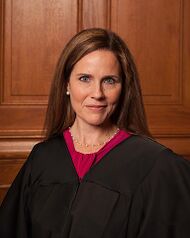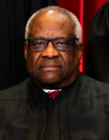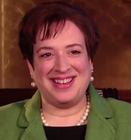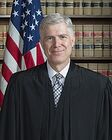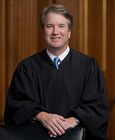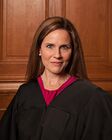Amy Coney Barrett
Amy Vivian Coney Barrett (born January 28, 1972) is an associate justice of the Supreme Court of the United States, the fifth woman Justice in U.S. history. She was previously a law professor at Notre Dame. President Donald Trump nominated her to the Seventh Circuit in 2017.
Trump has praised Barrett's legal mind, probably, but she has two other key assets. They let her thwart outrage that Justice Ruth Bader Ginsburg might be replaced by a male — taking everyone's eyes off the fact that Ginsburg was being replaced by a conservative.
Trump passed over Barrett during the contentious selection of Justice Brett Kavanaugh, saying about Barrett at the time, "I'm saving her for Ginsburg." When that third Supreme Court vacancy fell into Trump's lap in 2020, his choice was obvious (though Las Vegas still made book on it for two weeks).
Early life[edit]
Amy Vivian Coney was born in 1972 in New Orleans, Louisiana. In retrospect from the woke '20s, all the demographic cards were stacked against her. Her father worked in the oil industry, her mother was mostly a homemaker and probably never burned her bra. Coney was Catholic and, worst of all, undeniably white. Thus, she had to work harder in the age of Affirmative Action just to keep even.
Coney was the student body vice president in high school. She went to Rhodes College, joined the Ono Mato Poeia sorority, and graduated with high honors. She attended Notre Dame and got a law degree with highest honors, going from high to highest in a scant three years.
Legal career[edit]
From 1998 to 1999, under the assumed name Barrett, she clerked for Justice Antonin Scalia. Surely it was in this period that she got the bugs — both the judgeship bug and that Scalia bug to check what the Constitution says about a law in question, rather than pull an opinion from a bodily orifice, something that was in vogue in those days. Thereafter, she practiced law at a boutique law firm in Washington, D.C. Unfortunately, it is hard to find a boutique in Washington, unless one wishes to receive a cornrow braid, and Barrett wound up working on Bush v. Gore, receiving as a co-morbidity the bug for devising outrageous arguments to advance an awful Republican candidate.
After a cup of coffee at George Washington University, Barrett returned to Notre Dame in 2002 to teach law. One of the subjects she taught was stare decisis, the preposterous idea that, once the Court rules a certain way, citizens will best know how to act if they can assume the court will not do a flip-flop on the very next case that comes along. Thus, the court should try very hard to follow its previous rulings — unless it can devise an equally preposterous reason not to.
Circuit Court[edit]
In 2017, President Donald Trump nominated Barrett to the Seventh Circuit. Now her white-bread past would come back to haunt her, as Senator Dianne Feinstein (D-CA), despite advancing age, can smell a Catholic a hundred feet away. Anxious to uphold the settled law that the Constitution gives abortion policy for all 50 states directly to the Supreme Court, Feinstein worried aloud at the Senate confirmation hearing, "The dogma lives loudly within you." Barrett insisted she would not let her Catholicism bear on judging cases, but Feinstein feared Barrett had succumbed to the Dark Side of The Force.
An LGBT group also doubted Barrett's ability to throw her Catholicism to the curb and rule impartially. In fact, so many left-wing groups were having kittens over Barrett that a delighted Tea Party movement adopted her and started making noises that the Supreme Court was her destiny. Barrett fought off all her questioners so well that she was swiftly confirmed to the Court, lacking only all the Democrats.
Supreme Court[edit]
Trump famously followed a list for judicial vacancies that included Barrett. In 2018, when Justice Anthony Kennedy retired, Barrett was on the list of finalists, Trump insisting, "I really was willing to appoint you, more willing than a President has ever been, super-willing." But he went with Brett Kavanaugh — also a slam-dunk, so much so that Senators had to trot out the business of inducing college girls to attend high-school wine binges with a rape train and to return every week. Privately, Trump told both trusted aides and any FBI agents who were listening in on the call that "I'm saving [Barrett] for Ginsburg."
Happily for Trump, Ruth Bader Ginsburg — the "Notorious R.B.G." — went R.I.P. in September 2020 after a Republican death watch a mere 3½ years long, and Trump got a third Supreme Court vacancy to fill. Barrett (now "A.C.B.") was now a lock; Trump had survived a lot of things, but would not survive the notion of filling the Court with fewer women-and-minorities than it had before. However, he might survive appointing a non-Ivy Leaguer.
If politics entered into Republican thinking, the stick up Democrats' arses was deeper than ever before. In 2016, when the tables were turned, President Barack Obama nominated Merrick Garland to fill a vacancy and the Republicans dawdled a full ten months until Obama was turned out to the street. Democrats howled that Republicans had a duty to consistency to run out the clock on their own guy as well.
Not only was it close to a Presidential election but, in the wake of the Coronavirus, many states were changing their laws to allow voting without human contact. (Pennsylvania just ignored its laws, which was more efficient.) Barrett's Senate hearings occurred after voters had already begun mailing in ballots to get rid of Trump. Strangely, Democrats could not manufacture a reason to stall the hearings until Trump was out of office or at least repudiated by the voters. Not a rape train, not even a pubic hair on a Coke can. Barrett made "The Show" — without a single Democrat vote.
Senate Democratic leader Chuck Schumer (D-NY) called the politicized appointment "the most illegitimate process I have ever witnessed." Surely this means he had been locked in the cloakroom when Harry Reid (D-NV) cancelled the part of the filibuster rule that used to let a pathetic minority — like Schumer's — block confirmations.
Decisions[edit]
In 2020, Texas sued Pennsylvania for the injury caused to it by Pennsylvania voting for Joe Biden, and Trump turned to Barrett to repeat her Bush v. Gore magic, begging her and his other two appointees to invent a hokey reason for him to hang onto the Oval Office despite the Electoral College. Unfortunately, they followed the law, as Trump always said they would. Not since Marbury v. Madison (1803) have appointees bitten the hand that feeds them and invented a technicality not to do what they thought self-evident.[1]
Barrett reiterated in her Senate hearings her belief in stare decisis. In 2013, she wrote that seven Supreme Court cases were not just precedents but "super-precedents," virtually pencilled into the Constitution itself. But — where is Roe v. Wade? I don't see Roe! Barrett's cryptic answer was that your eagerness to see it in the list means it is so controversial that it should not be in the list — Catch-22!
As the reader is consulting a wiki for Barrett's life story, the reader surely wants to read evidence that she is a bald-faced hypocrite and does not practice what she preaches — say, that she really did vote to overturn established precedent on which the entire nation was relying. (Roe Roe Roe.) On this, the book is still out. There are only open letters and signatures on advertisements to suggest that Barrett was selling Senate Democrats a bill of goods. She is a vocal opponent of abortion, and has written that Obamacare ought not force churches to pay for The Pill for their employees. This means it is only a matter of time before Barrett ignores those high-minded words about precedent and begins overturning past rulings and delivering American jurisprudence into the hands of the Papists.
References[edit]
- ↑ Though a more recent analogy is the march to the crucifixion in Life of Brian (1979).
| ||||||||||||||||||||||||||
